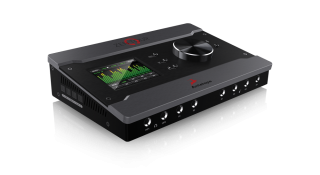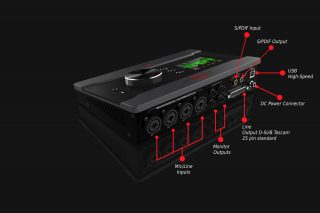 Antelope Audio announced its “most accessible and versatile recording tool” last week at Musikmesse 2016. Antelope’s Zen Tour features an ultra portable form factor, Thunderbolt and USB connectivity, 8 analog inputs and outputs, high-end DSP effects, hardware-based guitar amp/cab simulations and more.
Antelope Audio announced its “most accessible and versatile recording tool” last week at Musikmesse 2016. Antelope’s Zen Tour features an ultra portable form factor, Thunderbolt and USB connectivity, 8 analog inputs and outputs, high-end DSP effects, hardware-based guitar amp/cab simulations and more.
With 8 inputs, including 4 switchable Mic/Line inputs and 4 HiZ/Line inputs, Zen Tour provides plenty of options for tracking several instruments simultaneously — as well as digital ADAT & S/PDIF I/O for increased connectivity options.
 Zen Tour’s 8 outputs are designed to enable an all-in-one workflow, and dual independent headphone outputs enable two musicians (or a musician and engineer) to listen in without additional hardware. In addition, there are dual monitor outputs for A/B monitor switching, dual reamp outputs, and a talkback button on the front panel.
Zen Tour’s 8 outputs are designed to enable an all-in-one workflow, and dual independent headphone outputs enable two musicians (or a musician and engineer) to listen in without additional hardware. In addition, there are dual monitor outputs for A/B monitor switching, dual reamp outputs, and a talkback button on the front panel.
Zen Tour incorporates the same parallel DSP processing capabilities found on Antelope Audio’s professional studio devices, enabling low recording latency and the use of Antelope’s “hardware-quality” effects. With the low latency of Antelope’s Field-Programmable Gate Array (FPGA) processing, guitar amplifiers respond “with the same immediacy of real tubes, carrying an authentic tone and realistic sound.”
 Zen Tour also boasts innovative software-based hardware control, with its “impressive” touch screen, a handy mobile app, and a cross-platform software control panel. With its networking and remote control implementations, users are able to manage all Zen Tour features from multiple computers in the same network, as well as from a smart phone or tablet via iOS and Android mobile apps.
Zen Tour also boasts innovative software-based hardware control, with its “impressive” touch screen, a handy mobile app, and a cross-platform software control panel. With its networking and remote control implementations, users are able to manage all Zen Tour features from multiple computers in the same network, as well as from a smart phone or tablet via iOS and Android mobile apps.
Pricing and Availability. Antelope Audio’s Zen Tour portable audio interface is expected to begin shipping at the end of May, 2016 at the retail price of $1,495 / EUR 1,495.

FIRST !!!
The angle of the display just doesn’t seem right for a desk. I would have to hover over it to see it,right?
Actually when they make LCDs they can design it so the crystals are angled in a way that you can see them very clearly.
@leeg: the shape of it looks close to the Apogee Quartet (though the front panel is closer to horizontal than the Quartet’s) – I’ve got that one, and the displays are quite readable from a sitting position. It helps that they’re OLED, so there’s none of the viewing-angle color-inversion-strangeness that some LCD displays in older equipment have.
As a newbie I’m very happy with my Zoom thunderbolt sound card. Awesome bargain with ultra low latency.
16 channels of adat i/o in a portable interface is a big bonus for anyone using the expert sleepers modules and touring with a modular case….
Damn, that touch screen does look sexy. Wonder if thats going to be the next trend in audio interfaces moving forward.
Whoah, let me get this straight, they say it has 8 inputs, and it actually physically has 8 inputs? What is this? Since when do companies actually have on a device what it says it has?
Heh this looks pretty nice.
lacking of midi, as usual… otherwise it would have looked perfect.
damn marketing! why don’t make a full featured product once ever!!!
Any Decent DAW has MIDI capabilities already built in, why would you need it in an interface in the day and age? Most modern (early 2000) devices use USB for midi now.
M-Audio WEB page:The Deltabolt 1212 will be available in August 2015, however no one seen it in the shops yet. Hopefully this unit will come out, at least that they update the WEB page better that M-Audio,
I’m continually surprised that there is only one spdif input on most audio interfaces, even in this price range.
There’s a good reason for only a single SPDIF input. Most companies don’t build their interfaces from scratch; they rely on existing chipsets. For example, the TCD3020 18×18 USB audio controller IC only supports two channels of AES/SPDIF.
There’s 2 ADAT ports though, what are you looking for in more spdif?